 Scleroderma: Causes, Symptoms, and Natural Support Strategies
Scleroderma: Causes, Symptoms, and Natural Support Strategies
Scleroderma is a rare and chronic autoimmune disease characterized by hardening and tightening of the body’s connective tissue. Connective tissue is found throughout the body and adds strength and elasticity to organs and other parts of the body. It is made up of many proteins including collagen.
With scleroderma, cells make too much collagen which can affect the skin, joints, tendons, and internal organs. The extra collagen prevents the affected areas from functioning properly. There are two main types of scleroderma, limited and systemic.
Around 2.5 million people worldwide have scleroderma. The severity of scleroderma varies from person to person. For some people it is mild and for others it can be life threatening.
The exact cause of scleroderma is unknown. However, it appears that genetic and environmental factors play a role in the development of scleroderma. Diagnosis is very difficult because many of the symptoms are found in other autoimmune conditions.
One of the best natural support strategies for anyone with scleroderma is to follow an anti-inflammatory, autoimmune elimination diet. With this nutrition plan, you eliminate the most common immune provoking and pro-inflammatory foods that may be triggering an immune response. This article will discuss how to implement an autoimmune elimination diet along with other natural support strategies for scleroderma.

What is Scleroderma?
Scleroderma, or systemic sclerosis, is a chronic connective tissue disease generally classified as one of the autoimmune rheumatic diseases (1). The word “scleroderma” comes from two Greek words: “sclero” meaning hard, and “derma” meaning skin. Hardening of the skin is one of the most visible manifestations of the disease (2). Scleroderma can affect only the skin, but often also affects blood vessels, internal organs, the digestive tract, and other structures in the body.
Scleroderma is a type of autoimmune condition. An autoimmune condition occurs when the body’s immune system malfunctions and works against itself. A normal immune system protects the body by fighting off foreign invaders such as viruses and pathogens. With an autoimmune condition, the immune system mistakenly identifies healthy cells and tissues as foreign invaders and starts attacking and destroying them.
In scleroderma, cells start making collagen as if there were an injury that needs repairing. The cells do not turn off as they should and make too much collagen. The extra collagen in the tissues can prevent the body’s organs from functioning properly.
It is estimated that between 300,000-500,000 Americans and 2.5 million people worldwide have scleroderma. As with many other autoimmune conditions, scleroderma affects more women than men. The common age span for systemic scleroderma to develop is between 30 and 50.
Scleroderma often accompanies other immune system disorders such as autoimmune thyroid disease. It is common for people who have scleroderma to also have a rheumatic disease such as lupus or rheumatoid arthritis.
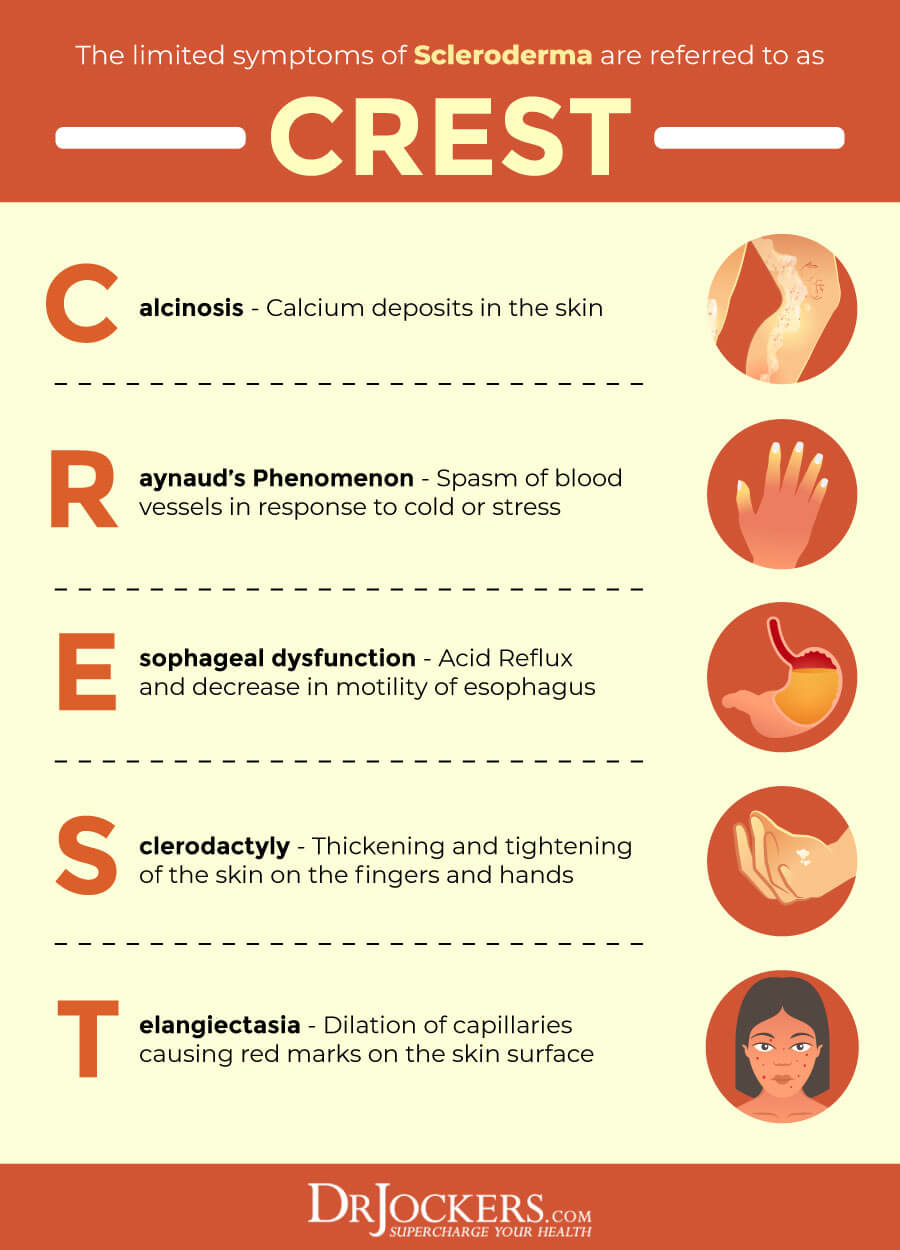
Types of Scleroderma
There are two major types of scleroderma: localized scleroderma and systemic scleroderma (systemic sclerosis). Localized scleroderma is more common in children, and systemic is more common in adults.
Localized Scleroderma
The changes are usually found in only a few places on the skin or muscles, and rarely spread elsewhere. Generally, localized scleroderma is relatively mild. The internal organs are usually not affected, and individuals with localized scleroderma rarely develop systemic scleroderma.
There are different forms of localized scleroderma:
- Morphea is a form of localized scleroderma characterized by waxy patches on the skin of varying sizes, shapes, and color. The skin under the patches may thicken. The patches may enlarge or shrink, and often may disappear spontaneously. Morphea usually appears in adults between the ages of 20 and 50.
- Linear scleroderma is a form of localized scleroderma which frequently starts as a streak or line of hardened, waxy skin on an arm or leg or on the forehead. Sometimes it forms a long crease on the head or neck, resembling a saber or sword wound. Linear scleroderma tends to involve deeper layers of the skin as well as the surface layers, and sometimes affects the motion of the joints, which lie underneath. Linear scleroderma usually develops in childhood and may affect the growth of involved limbs.
Systemic scleroderma (systemic sclerosis)
In systemic scleroderma, the connective tissue in many parts of the body is affected. Systemic scleroderma can involve the skin, esophagus, gastrointestinal tract (stomach and bowels), lungs, kidneys, heart and other internal organs. It can also affect blood vessels, muscles, and joints. The tissues of involved organs become hard and fibrous, causing them to function less efficiently.
The term systemic sclerosis indicates that “sclerosis” (hardening) may occur in the internal systems of the body. There are two major recognized patterns that the illness can take: diffuse or limited. In diffuse scleroderma, skin thickening occurs more rapidly and involves more skin areas than in limited disease. In addition, people with diffuse scleroderma have a higher risk of developing “sclerosis” or fibrous hardening of the internal organs.
In limited scleroderma, skin thickening is less widespread, typically confined to the fingers, hands, and face, and develops slowly over years. Although internal problems occur, they are less frequent and tend to be less severe than in diffuse scleroderma and are usually delayed in onset for several years.
Limited scleroderma is sometimes called CREST syndrome. CREST stands for the initial letters of five common features:
- Calcinosis
- Raynaud Phenomenon
- Esophageal dysfunction
- Sclerodactyly
- Telangiectasia
Some people with diffuse scleroderma will go on to develop calcinosis and telangiectasias so that they also have the features of CREST. Although most individuals can be classified as having diffuse or limited disease, different people may have different symptoms and different combinations of symptoms.
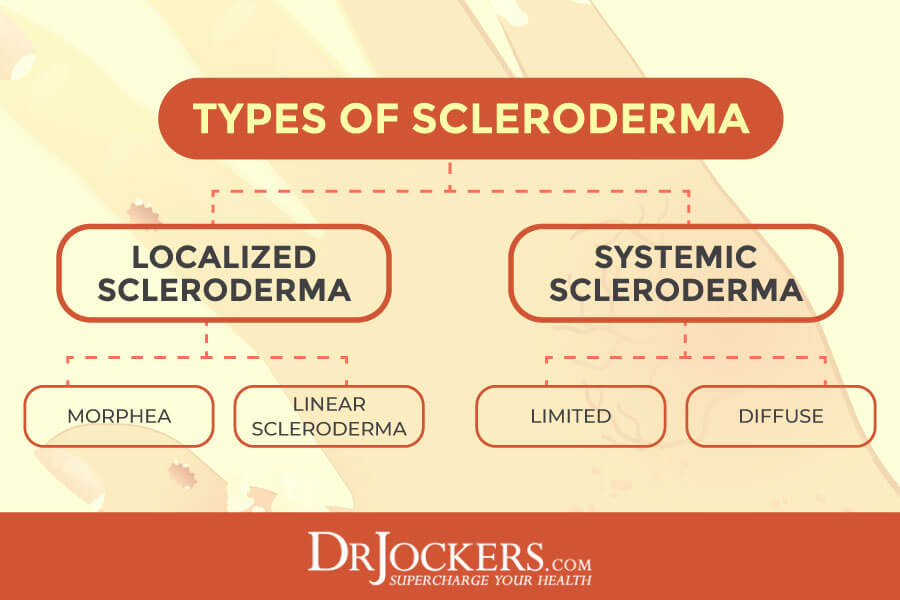
Symptoms of Scleroderma
Symptoms of scleroderma vary in type and intensity depending on which parts of the body are affected. Most people with systemic scleroderma experience a broad range of symptoms such as fatigue, pain, impaired hand function, dry mouth, and sleeping difficulties (3).
Symptoms of scleroderma include:
- Skin: Nearly everyone who has scleroderma experiences a hardening and tightening of patches of skin. These patches may be shaped like ovals or straight lines or cover wide areas of the trunk and limbs. The number, location, and size of the patches vary by type of scleroderma. Skin can appear shiny because it is so tight, and movement of the affected area may be restricted.
- Fingers or toes: One of the earliest signs of systemic scleroderma is Raynaud’s phenomenon, which causes the small blood vessels in your fingers and toes to contract in response to cold temperatures or emotional distress. When this happens, your fingers or toes may turn white and feel painful or numb.
- Digestive system: Scleroderma can cause a variety of digestive symptoms, depending on which part of the digestive tract is affected. If the esophagus is affected, you might have heartburn or difficulty swallowing. If the intestines are affected, you might have cramps, bloating, diarrhea, or constipation. Some people who have scleroderma may also have problems absorbing nutrients if their intestinal muscles are not properly moving food through the intestines.
- Heart, lungs or kidneys: Scleroderma can affect the function of the heart, lungs or kidneys to varying degrees. These problems, if left untreated, can become life-threatening.
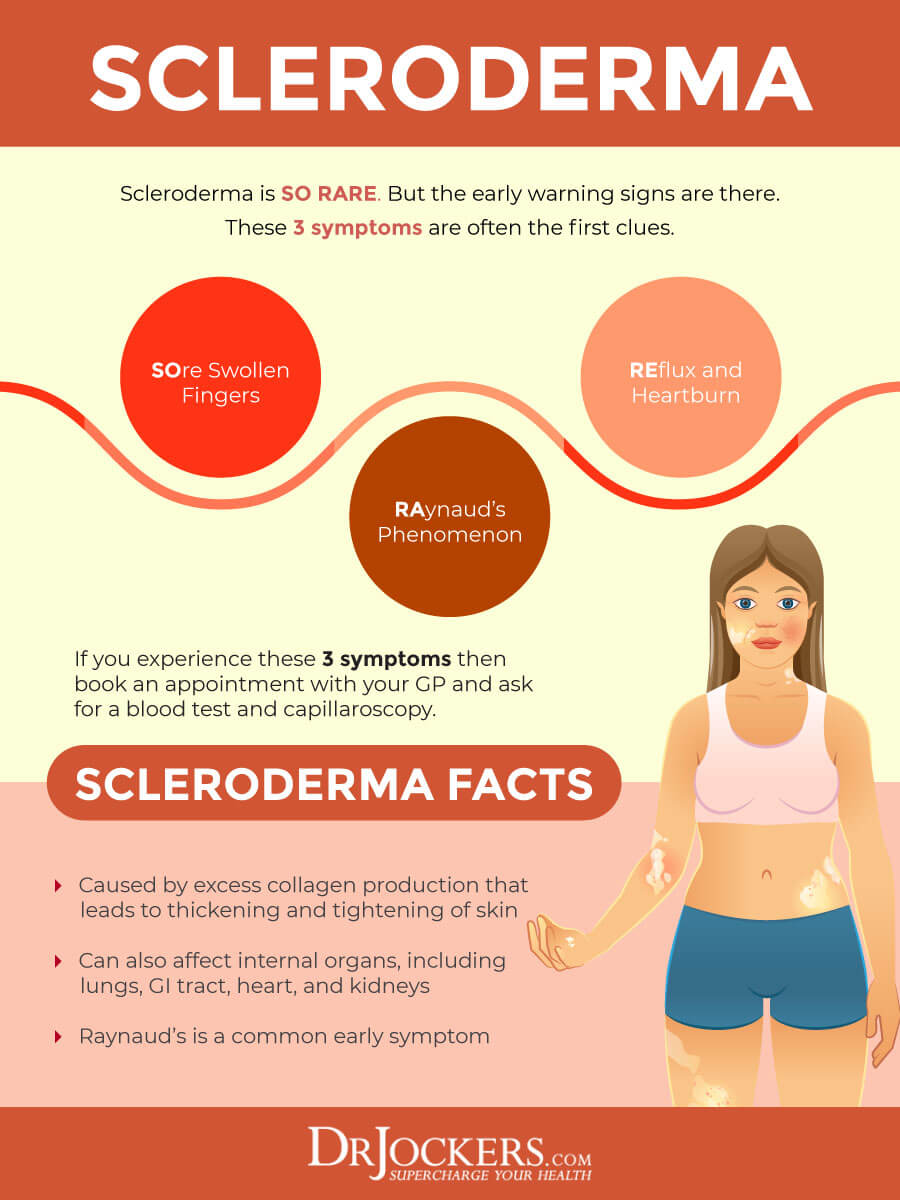
Complications and Manifestations of Systemic Scleroderma
Complications and manifestations of systemic scleroderma include (2):
Pulmonary Impairment
Systemic scleroderma can lead to interstitial lung disease (ILD) and pulmonary arterial hypertension (PAH). These two complications are the leading causes of death in systemic scleroderma.
Pulmonary arterial hypertension
Pulmonary arterial hypertension (PAH) occurs in up to 13% of individuals with systemic scleroderma. It occurs more commonly in patients with limited cutaneous systemic sclerosis. Pulmonary hypertension is a condition in which the lungs’ blood vessels become narrow, leading to impaired blood flow through the lungs, resulting in shortness of breath.
Interstitial lung disease (ILD)
Interstitial lung disease (ILD) is common in patients with systemic scleroderma. Systemic scleroderma-ILD appears in the early years of the disease, and its most marked progression occurs in the first years after diagnosis. About 12% of scleroderma patients will progress to terminal respiratory failure.
Gastrointestinal manifestations
Gastrointestinal involvement in systemic scleroderma involves the whole digestive tract. Gastroesophageal reflux disease (GERD) occurs in 75 to 90% of people with systemic scleroderma. Motor impairment can also affect the stomach, causing gastroparesis and more rarely watermelon stomach, a condition related to gastric antral vascular ectasia.
Motor impairment also leads to small intestinal bacterial overgrowth (SIBO), nutritional deficiencies (folate and vitamin B12), malabsorption (steatorrhea), and pseudo-obstruction. Anorectal involvement may cause fecal incontinence and rectal prolapse.
Cardiac manifestations
Cardiac involvement is common in systemic scleroderma and includes myocardial disease, conduction system defects, arrhythmias, or pericardial disease.
Renal involvement
Renal involvement is common in people with systemic scleroderma. The most serious manifestation is scleroderma renal crisis (SRC) which is a rare but major complication. SRC is more common in patients with diffuse systemic scleroderma. Doctors use angiotensin-converting enzyme (ACE) inhibitors in individuals with SRC.
Musculoskeletal Manifestations
Scleroderma may affect joints (arthritis, arthralgia), tendons (rubs, tenosynovitis) and muscles (myalgia, weakness, more rarely myositis). Friction tendon rubs, seen on the hands, knees, and ankles, indicate a poor prognosis. Digital retractions in flexion due to skin sclerosis and calcinosis, lead to major functional disorders.
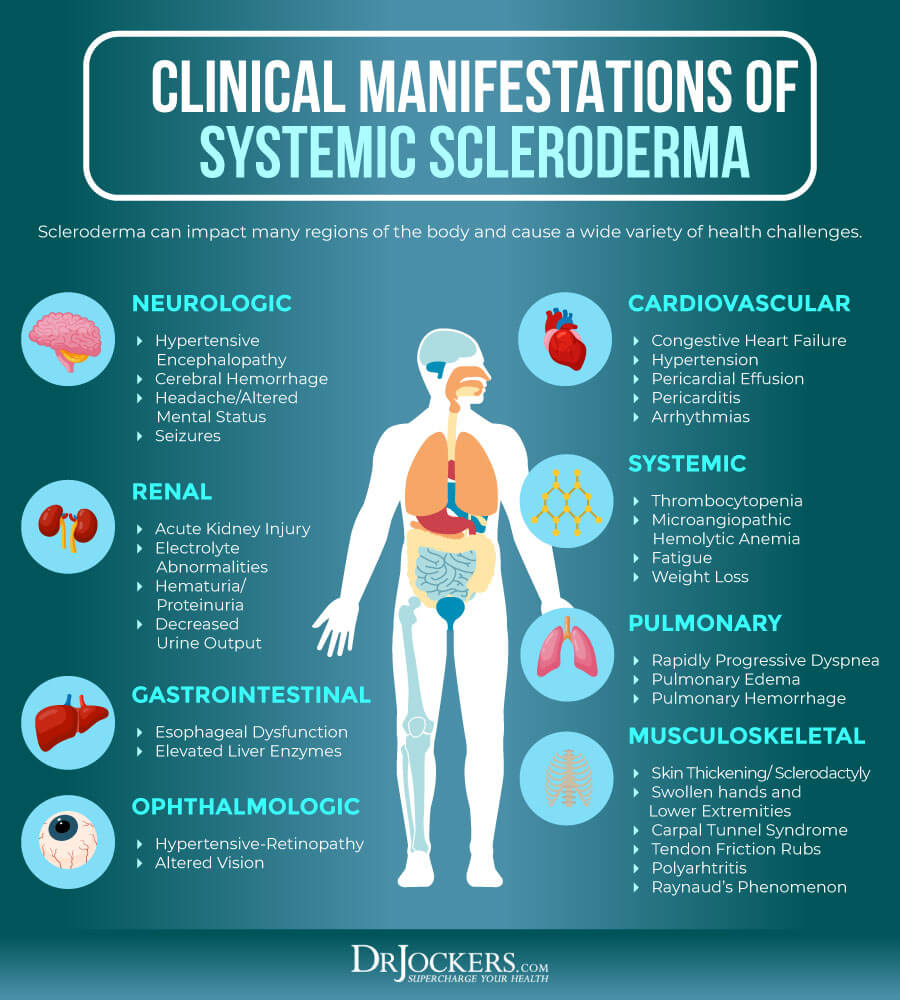
Causes of Scleroderma
The exact cause of scleroderma, as with other autoimmune conditions, is not clear. Abnormal activity in the immune system causes cells to overproduce collagen, which in turn causes connective tissue to build up.
Research suggests there may be a genetic susceptibility to scleroderma and different environmental triggers that bring on the condition (4). Dating back to 1914, studies have found an association between occupational exposures of inhaled particulates and scleroderma (5). These include exposure to silica dust, asbestos, and certain industrial solvents (such as paint thinners).
Dysbiosis and intestinal permeability are also a factor in many autoimmune conditions. Dysbiosis is an imbalance of the bacteria in the gut, which heavily regulate the immune system. Intestinal permeability (leaky gut) is caused when the cells that line the digestive tract are damaged.
The cell lining is only one cell thick. When this layer is damaged, it becomes porous. Foods and other things can penetrate the gut lining and activate the immune system, leading to an autoimmune condition.

Diagnosing Scleroderma
Scleroderma can be difficult to diagnose because symptoms frequently overlap with or “mimic” those of other conditions. Doctors will run tests to confirm the diagnosis and to look for complications.
Tests that are often performed if systemic scleroderma is suspected include:
- Nailfold capillaroscopy
- Screening for antinuclear antibodies
- Transthoracic echocardiography
- HRCT of the chest
- Diffusing capacity of the lung for carbon monoxide (DLCO) and spirometry
- Hand X-ray
- Esophageal manometry
When the diagnosis of systemic scleroderma is established, doctors may also perform these tests:
- Electrocardiogram
- Complete blood count
- Renal and liver functions
- Urinalysis
- NT-pro-BNP dosage
- Upper gastrointestinal endoscopy
There is no known cure for scleroderma. Doctors prescribe medications to manage symptoms. These include proton pump inhibitors or PPIs for heartburn, diuretics for high blood pressure, over the counter pain relievers for pain, and prescription drugs to suppress the immune system.
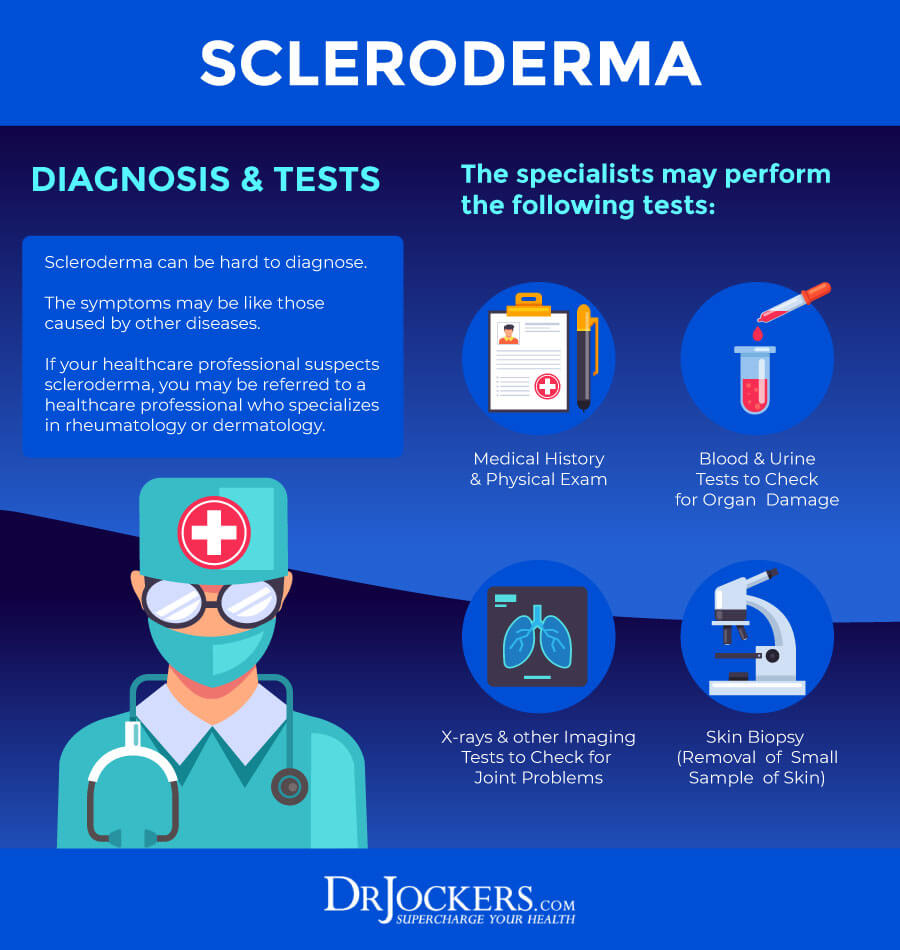
Food Sensitivities and Autoimmunity
It is important to understand the role that food sensitivities play in autoimmune conditions like scleroderma. A food sensitivity is an immune-mediated response to certain foods. When you have food sensitivities, your immune system reacts to certain foods as a threat, amplifying the immune response.
Repeated exposure to the foods causes inflammation and other health problems. The consequences of food-induced immune system activation can be subtle initially but may become serious over time.
A recent observational study found a clear difference in food sensitivity profiles for people with autoimmune diseases (6). IgG levels for specific food antibodies were significantly higher in patients with autoimmune conditions, which means they had a greater immune reaction to these foods.
Food sensitivities can be hard to identify. Symptoms can include gut issues, migraines, fatigue, joint pain, skin issues, and many others. These symptoms may be delayed up to 72 hours after consuming the offending food. There are various tests which measure your immune reaction to foods. You can learn more about testing in this article.

Natural Support Strategies for Scleroderma
There are natural strategies to help support individuals with scleroderma. While these strategies are not FDA approved to prevent, mitigate, treat, or cure scleroderma, they may be helpful for supporting the body and improving gut health and inflammatory expression.
1. Implement an Anti-Inflammatory Autoimmune Elimination Diet
An anti-inflammatory, autoimmune elimination diet can be a powerful natural strategy for scleroderma. This nutrition plan removes pro-inflammatory foods.
It also eliminates the most common foods which may be contributing to or causing an immune reaction and inflammation. The goal in eliminating these foods is to identify foods that may be contributing to negative symptoms of scleroderma.
Foods Excluded
The autoimmune diet eliminates foods that most commonly cause an immune response. These include gluten, dairy, eggs, peanuts, tree nuts, soy, wheat, fish, and shellfish. Many people are also sensitive to nightshade vegetables (tomatoes, potatoes, eggplant, bell peppers), corn, legumes, and all grains. After a 6-week elimination period, foods are slowly reintroduced, one at a time, noting any reactions and symptoms you may experience.
In addition to doing the autoimmune elimination diet, it is important to indefinitely avoid foods that cause inflammation including:
- Sugar
- Refined carbohydrates (white flour, white rice, white potatoes)
- Conventionally raised meat and dairy
- Farm-raised fish
- Processed foods, including meats.
- Trans fats (partially hydrogenated oils)
- Mono-sodium Glutamate (MSG) and other food additives and preservatives
- Highly processed vegetable and seed oils, such as canola, corn, sunflower, peanut, grapeseed, cottonseed, and safflower
- Artificial Sweeteners.
It is critical to avoid foods with pesticides and added chemicals, which have been linked to autoimmune conditions (7).

Foods Included
Foods included in the autoimmune diet include healthy fats, clean-sourced protein, and low to moderate carbohydrate vegetables, fruits, and herbs. These foods help to reduce inflammation and support the immune system.
Healthy Fats
Consuming plenty of healthy fats is very important on the autoimmune diet. Healthy fats are found in coconut, olives, avocados, and their oils and in grass-fed butter and ghee. Pumpkin, flax, hemp, and chia seeds, and borage, hemp, or flax oils are additional sources of good fats.
Omega-3 fatty acids and conjugated linoleic acid (CLA) found in wild-caught salmon and grass-fed beef and dairy have many health benefits. These healthy fats are an efficient source of fuel for the body to combat inflammation.

Clean Protein
Great protein sources are grass-fed, pasture-raised, and organic meats. Beef, bison, lamb, buffalo, venison, chicken, pheasant, duck and turkey are all included.
Wild-caught fish such as Alaskan Sockeye salmon is an excellent choice. Hypoallergenic brown rice or pea proteins can be used as well as bone broth from clean-sourced animals.
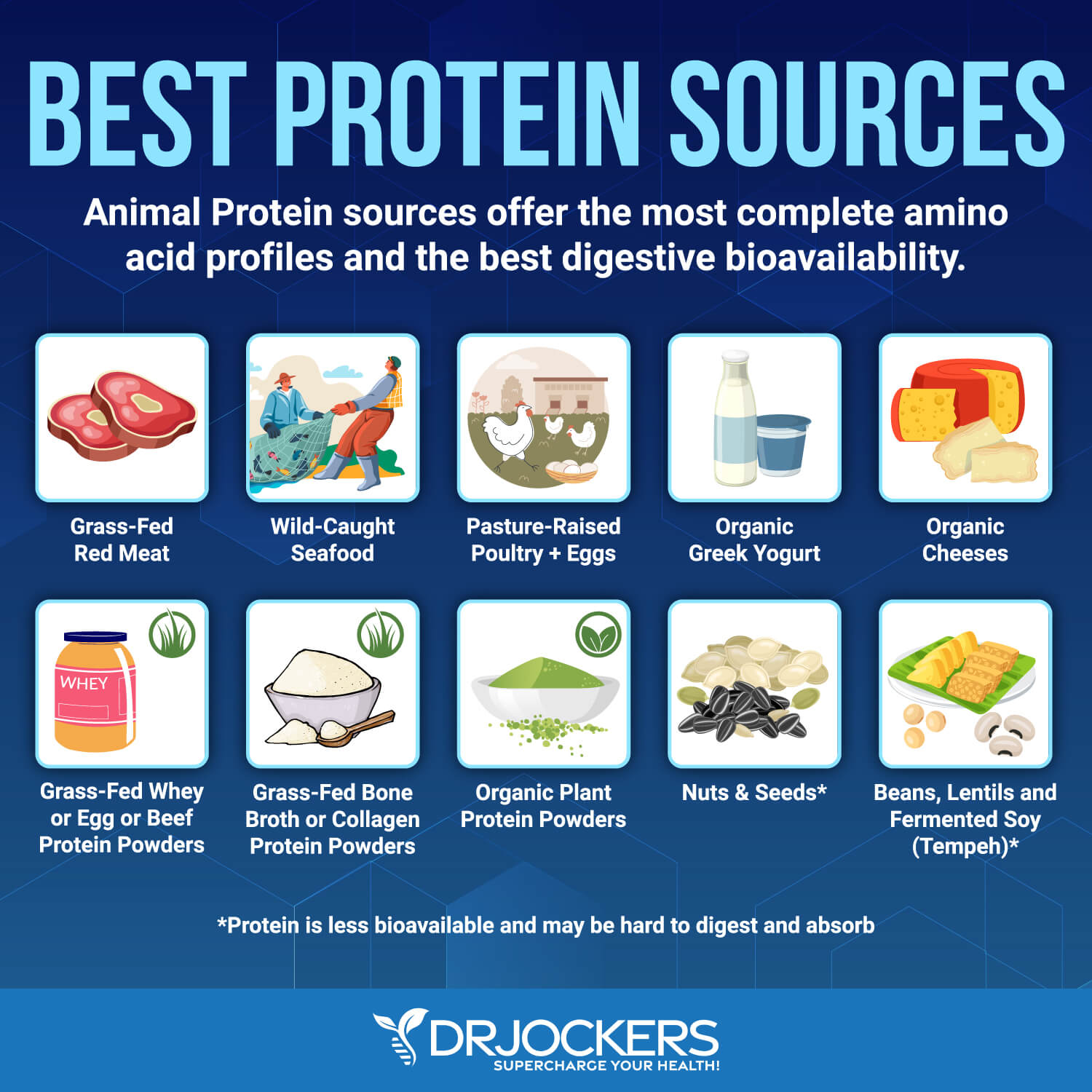
Vegetables, Fruits, and Herbs
A variety of low to moderate carbohydrate vegetables and fruits should be included for their abundant antioxidants and phytonutrients. Examples are cruciferous vegetables, cucumbers, asparagus, and leafy greens. Fruits to include on the autoimmune diet are berries, lemons and limes, grapefruits, goji berries, avocados, coconuts, and Granny Smith apples.
Herbs like rosemary, oregano, basil, cilantro, sage, and thyme have healing properties and are included in the autoimmune diet. Spices and sweeteners like cinnamon, garlic, ginger, turmeric, salt, stevia, and monk fruit are allowed, but not cayenne and paprika.
Other Foods to Include
Fermented foods and teas are excellent to include on the autoimmune diet. Organic green tea and organic herbal teas like ginger, Pau D Arco, and Nighty Night are great choices.
Fermented foods should be made without nightshade vegetables. These include coconut milk kefir or yogurt, fermented vegetables, kombucha, coconut water kefir, kimchi, and sauerkraut. Coconut milk, yogurt, and kefir are fantastic dairy substitutes.
Other coconut products like coconut butter, coconut flour, and unsweetened coconut flakes are included on this diet, as well as flax crackers and organic raw apple cider vinegar.
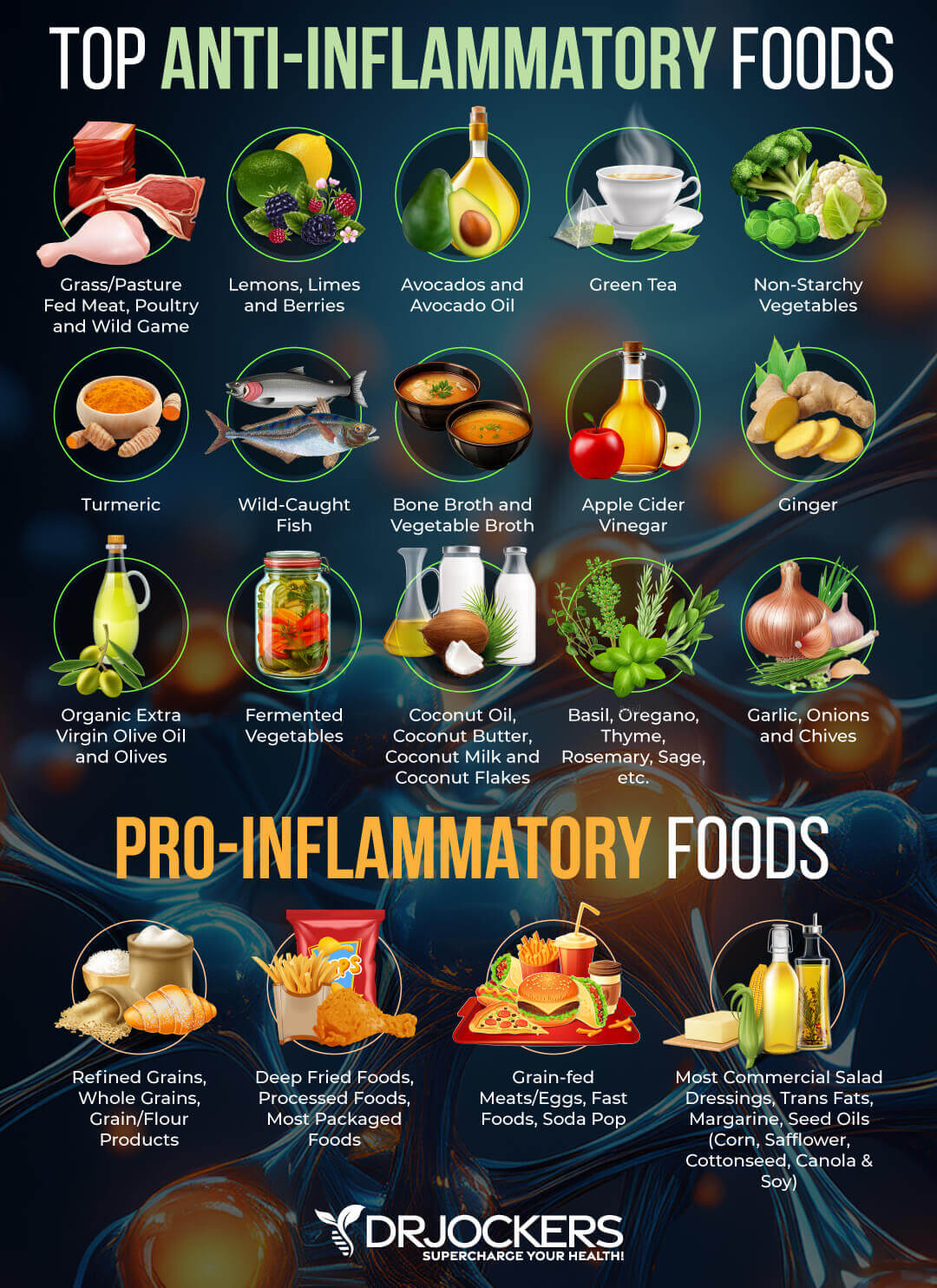
2. Address Raynaud’s Phenomenon
Raynaud’s phenomenon is very common in people with scleroderma. This condition causes the ends of the fingers and toes to feel cold, numb, and tingly. With Raynaud’s, blood vessels in the hands and feet overreact to cold temperatures or stress, constricting blood flow to affected tissue. The skin can change colors, from white to blue to red.
There are two types of Raynaud’s, primary Raynaud’s and secondary Raynaud’s. Secondary Raynaud’s is associated with scleroderma. In people suffering from both Raynaud’s and scleroderma, the small blood vessels in the skin gradually change in size, permanently becoming smaller, and may even disappear completely.
The most important support strategy for Raynaud’s is to avoid cold temperatures. Other natural strategies that may help to improve Raynaud’s are an anti-inflammatory diet with warming foods, acupuncture, using essential oils, managing stress, and chiropractic care.
Avoiding and detoxing your body from chemicals and heavy metals is very important. It is also important to test for and reduce high levels of homocysteine and to avoid nicotine and other vasoconstrictors. For more information about natural support strategies for Raynaud’s check out this article.
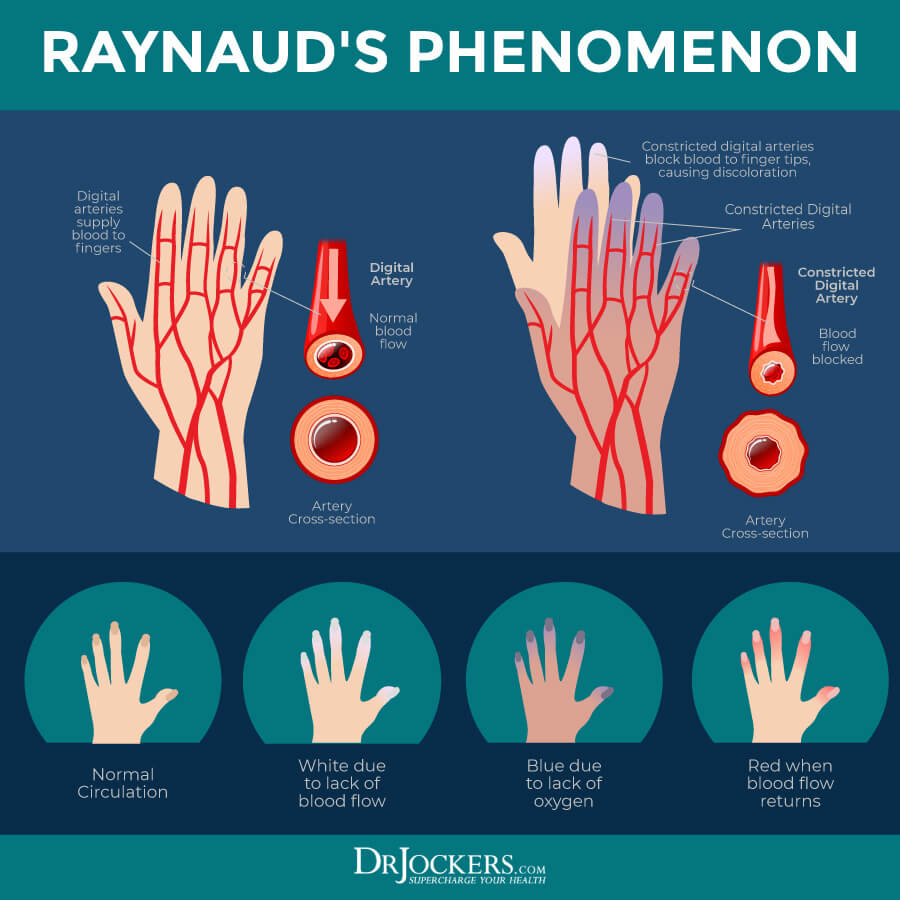
3. Support Your Mitochondria
Mitochondria are the energy powerhouses of your cells. They have essential roles in the body including producing the energy carrying molecule Adenosine Triphosphate (ATP), maintaining glutathione levels, protecting DNA, signaling cell reproduction, activating cell apoptosis, and maintaining cell electrochemical integrity.
Many autoimmune diseases appear to have a mitochondrial basis (8). Mitochondrial impairment is also a factor in inflammation. Calorie restriction (such as intermittent fasting), exercise, restorative sleep, and managing stress are ways to support your mitochondria.
Using mitochondrial support nutrients such as CoQ10, alpha lipoic acid, D-Ribose, Acetyl-L-Carnitine, magnesium, B vitamins and creatine may also be very helpful.
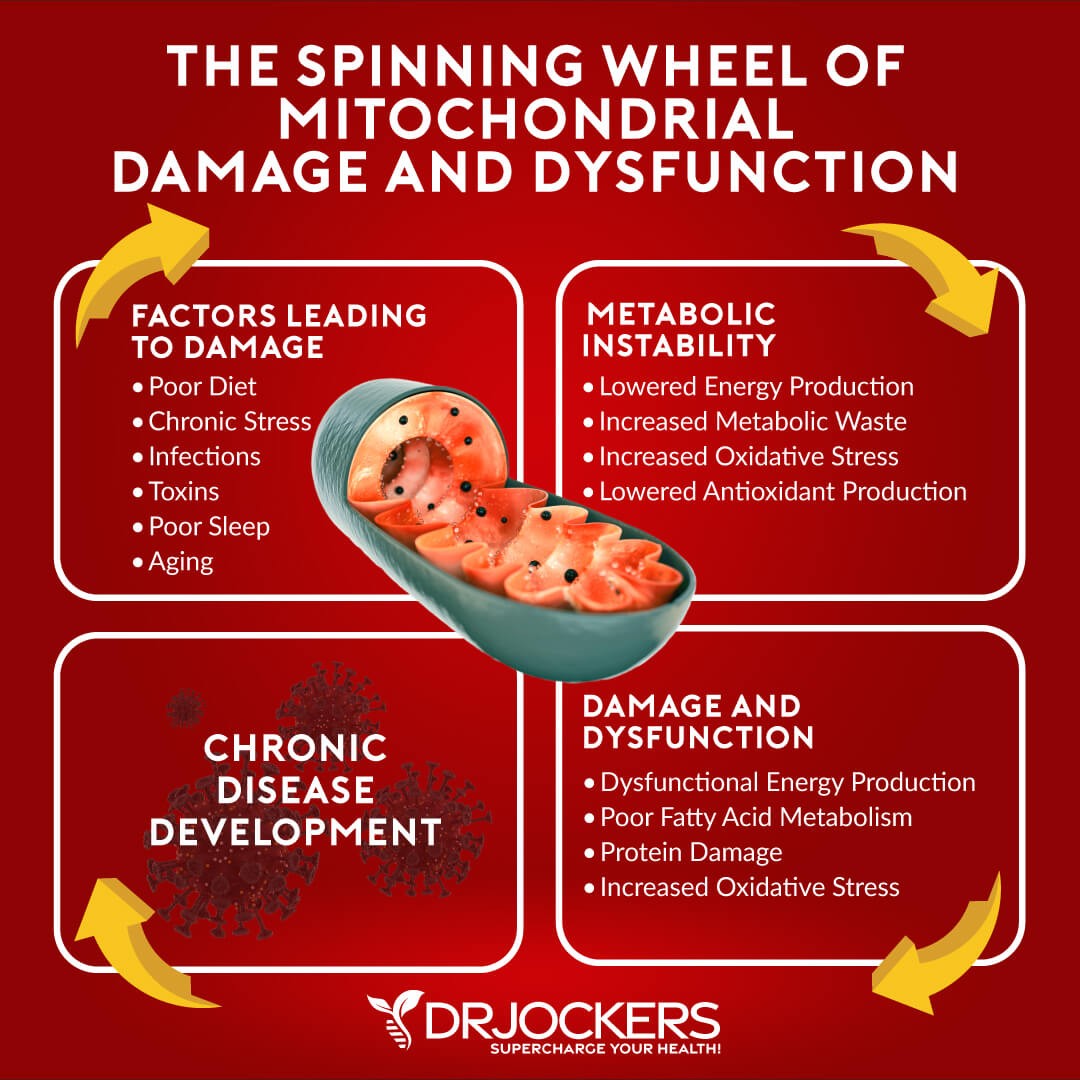
4. Support Gut Health
An important support strategy for scleroderma is to heal and repair your gut. Leaky gut syndrome, or intestinal hyperpermeability, is a condition in which the tight junctions in the gut lining become too large and abnormally permeable. Undigested food particles and toxins can pass through these holes in the intestinal wall and into the bloodstream. This causes the immune system to overreact and results in chronic inflammation, food sensitivities, and may lead to autoimmune conditions.
Reducing stress on the gut with liquid nutrition and fasting can be very effective for repairing leaky gut. Digesting, processing, and assimilating solid foods creates significant stress on the digestive system, irritates the gut lining, and leads to inflammatory processes. With fasting and liquid nutrition, our bodies can conserve the energy used in digestion and use this energy for healing and detoxification.
Using liquid nutrition also stimulates the digestive process and increases nutrient absorption. A great option for liquid nutrition is a shake with a good quality cleansing protein powder that provides high-quality hypoallergenic amino acids and powerful antioxidants to support gut function and improve detoxification.
Another fantastic combination to soothe an irritated gut lining and reduce inflammation includes the amino acid l-glutamine, along with aloe vera, arabinogalactan, and licorice. This powerful combination helps to support gut and immune function and to reduce inflammation in the gut.
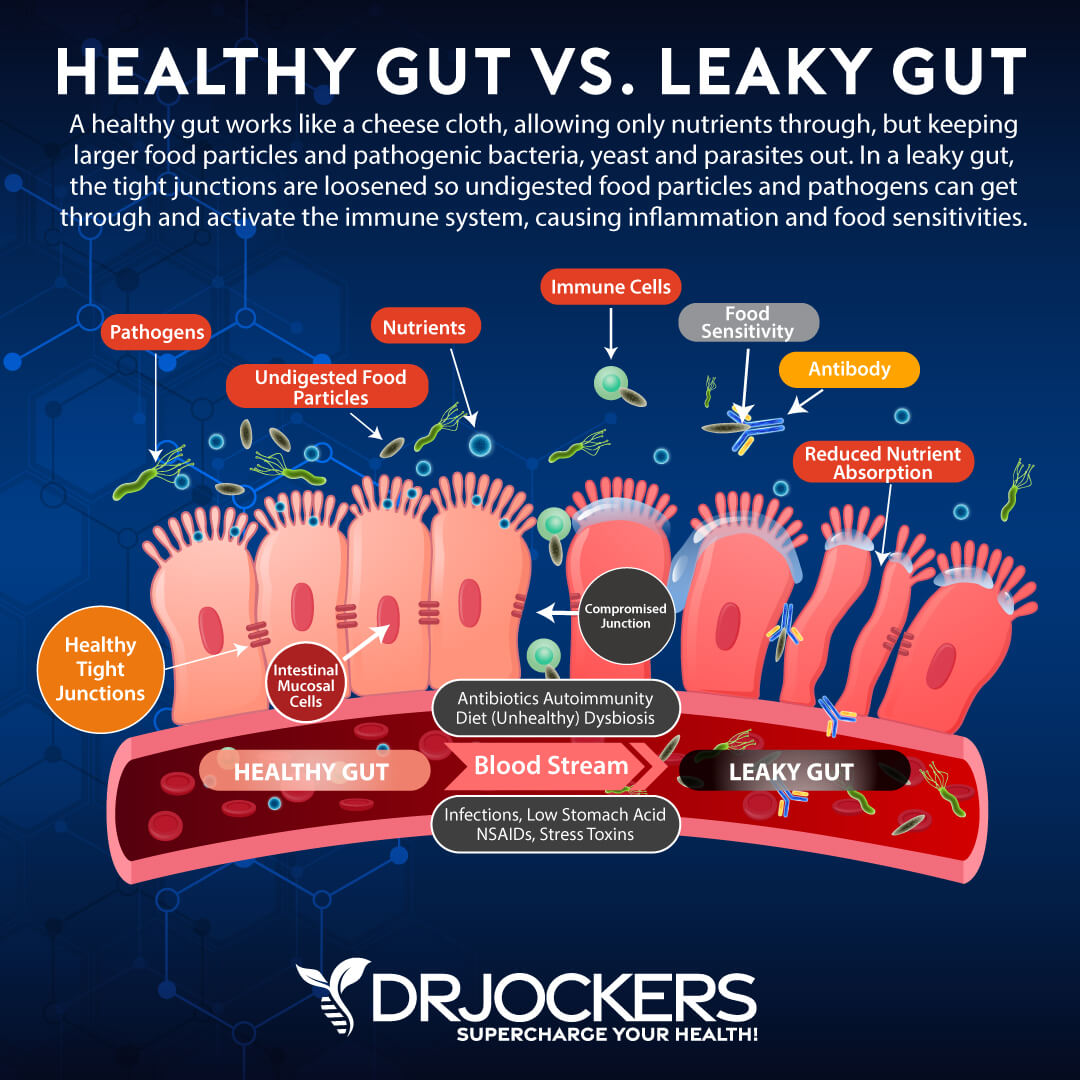
5. Strengthen Gut Mucosa
The gut mucosa is a protective barrier that lines the digestive tract. It houses the gut microbiome, aids in the absorption of nutrients, and protects us from pathogens, toxins, and dietary antigens. It is a vital part of the immune system and contains intestinal immunomodulatory cells that control immune responses and reduce inflammation. Strengthening the gut mucosa is an important strategy for improving Scleroderma.
For mucosal support, I like nutrients like L-glutamine, aloe vera, licorice root, vitamin C, colostrum and dairy-free, bovine serum-derived (BSD) immunoglobulin concentrate. These all act to support gut barrier function, improve immunity, and decrease inflammation in the gut.
The immunoglobulins in colostrum and BSD immunoglobulin concentrate work to bind to environmental toxins, neutralize pathogens, and improve gut mucosal immunoglobulin sIgA levels.
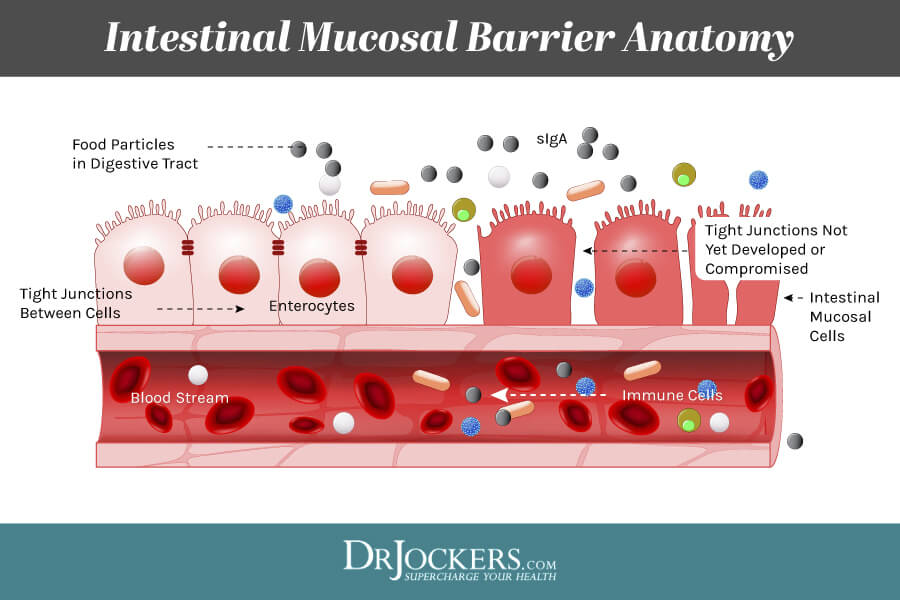
6. Support Immune Health
Scleroderma occurs due to a dysfunctional immune system. Supporting immune system function with antioxidants and nutrients helps to modulate immune system function.
You can look for immune support nutrients such as olive leaf extract, beta glucan, and vitamin C. Olive leaf is a powerful herb with antibacterial, antifungal, and antiviral effects. It inhibits viral reproduction and supports the immune system in fighting viruses. Beta glucan is a balancing immune modulator that helps to bind to white blood cells and improve their immune coordination. Vitamin C is an antioxidant that supports immune system function.
Vitamin D is important for regulating the immune system, and low levels are linked to many autoimmune conditions. Low levels of vitamin D are very common in systemic scleroderma (9). Deficiencies in vitamin D are related to a more aggressive disease with multi-visceral and several organ involvement, especially pulmonary and cardiac involvement.
Many people have a difficult time getting enough vitamin D from the sun and food and benefit from vitamin D supplementation. Vitamin D may be helpful in scleroderma due to its immunomodulatory, cardioprotective, and antifibrotic properties.
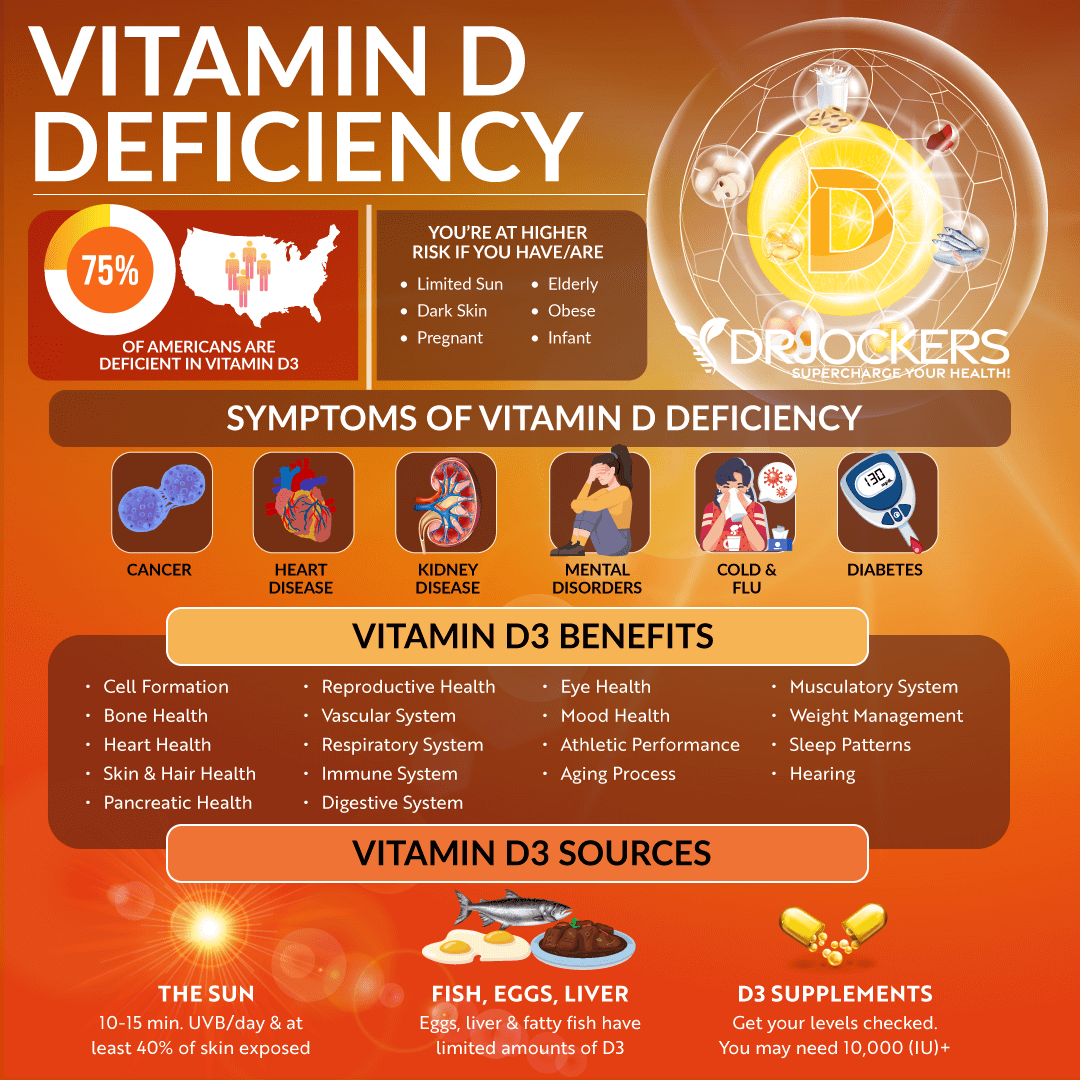
7. Moisturize the Skin
Patients with scleroderma suffer from dry, stiff, and thick skin. Keeping the skin moisturized may be helpful.
Natural moisturizers like coconut oil, olive oil, almond oil, and shea butter are great options. As a cooling agent, essential oils with menthol can help to reduce inflammation, reduce itchiness and relieve pain. Try combining 1–2 drops of peppermint oil with ½ teaspoon of coconut oil. Apply the mixture topically to the skin. Start by doing a patch test on a small area of skin to make sure that the peppermint is not irritating before you apply it to a larger area.
It is important to avoid harsh soaps, laundry detergent, and household cleaners that contain dangerous chemicals, which can make symptoms worse. These should be free of parabens, synthetic colours, phthalates, triclosan, sodium lauryl ether sulphate, formaldehyde, toluene, and propylene glycol. Also, too much sun exposure and taking very hot showers or baths can dry the skin. In the winter months, using a humidifier can be helpful.

8. Targeted Supplementation
There are several supplements that may help to improve the health of those with scleroderma. It is important to remember that these are not FDA approved to prevent, mitigate, treat or cure scleroderma but may improve the health of those who struggle with this condition.
Proteolytic Enzymes
Enzymes are biocatalysts that help to carry out and speed up chemical reactions in our bodies. Systemic enzymes are used by our bodies to carry out virtually every metabolic function. They have a powerful effect on the immune system and have incredible anti-inflammatory activity (10).
Proteolytic or systemic enzymes are used to clean up fibrotic (scar) tissue in the body. These enzymes digest fibrolytic tissue and prevent fibrosis of our organs and tissues. Using proteolytic enzymes can help to break down antibodies in scleroderma and improve the range of motion in restricted joints. It is important to note that these compounds are not FDA approved to prevent, mitigate, treat or cure scleroderma and should not be confused as such.
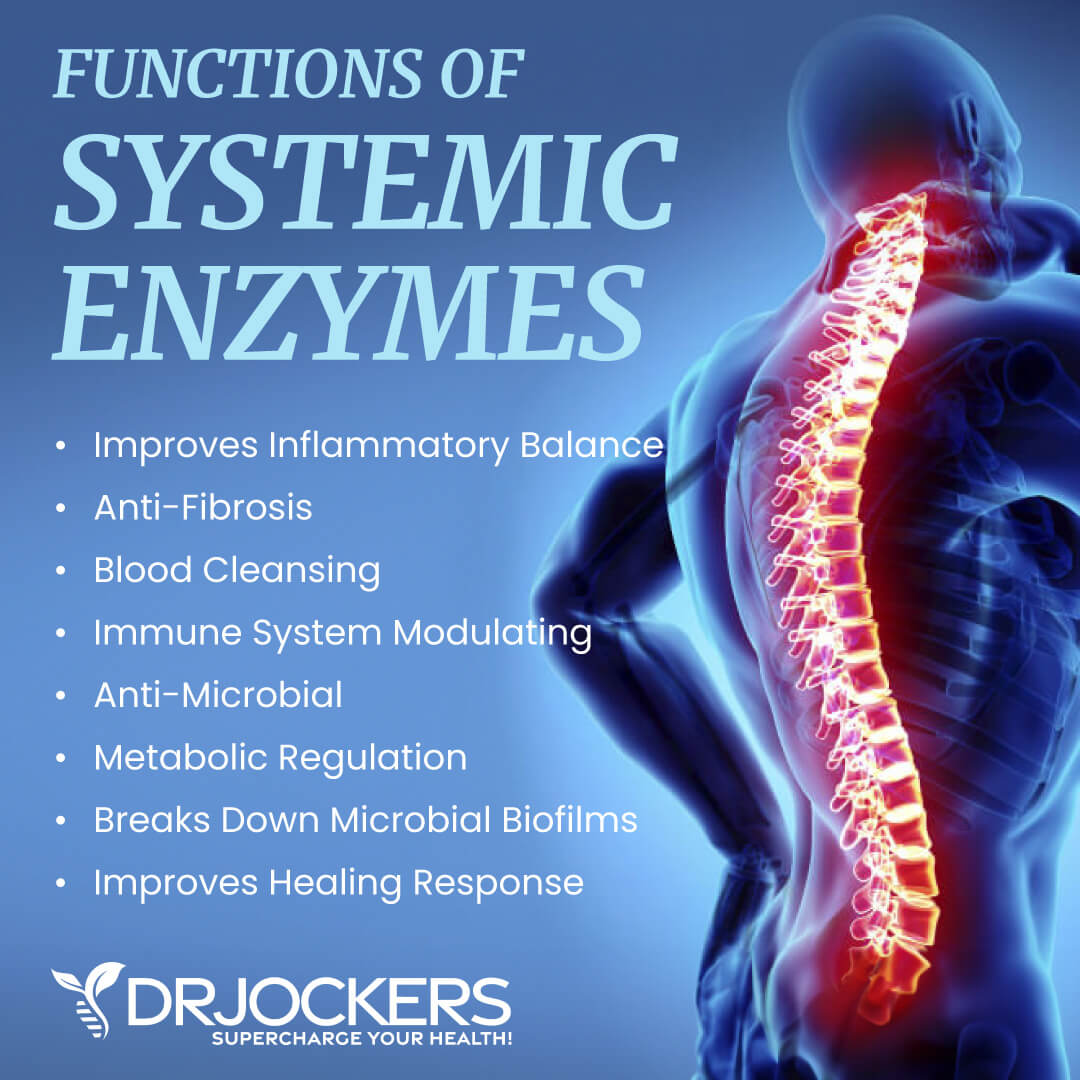
Resveratrol
Resveratrol is a natural polyphenol produced by red grapes. It has multiple beneficial properties including antiaging, immunoregulatory, and skin improving properties (11). It is a strong antioxidant and free radical scavenger with anti-inflammatory and anti-tumoral effects. It has a therapeutic effect on systemic autoimmune conditions.
I will often recommend a combination of resveratrol and the plant flavonoid quercetin together. This synergy of nutrients may defend against oxidative damage, lower inflammation, and support optimal immune health. This combination also supports skin health and improves circulation. It is important to note that these compounds are not FDA approved to prevent, mitigate, treat or cure scleroderma and should not be confused as such.
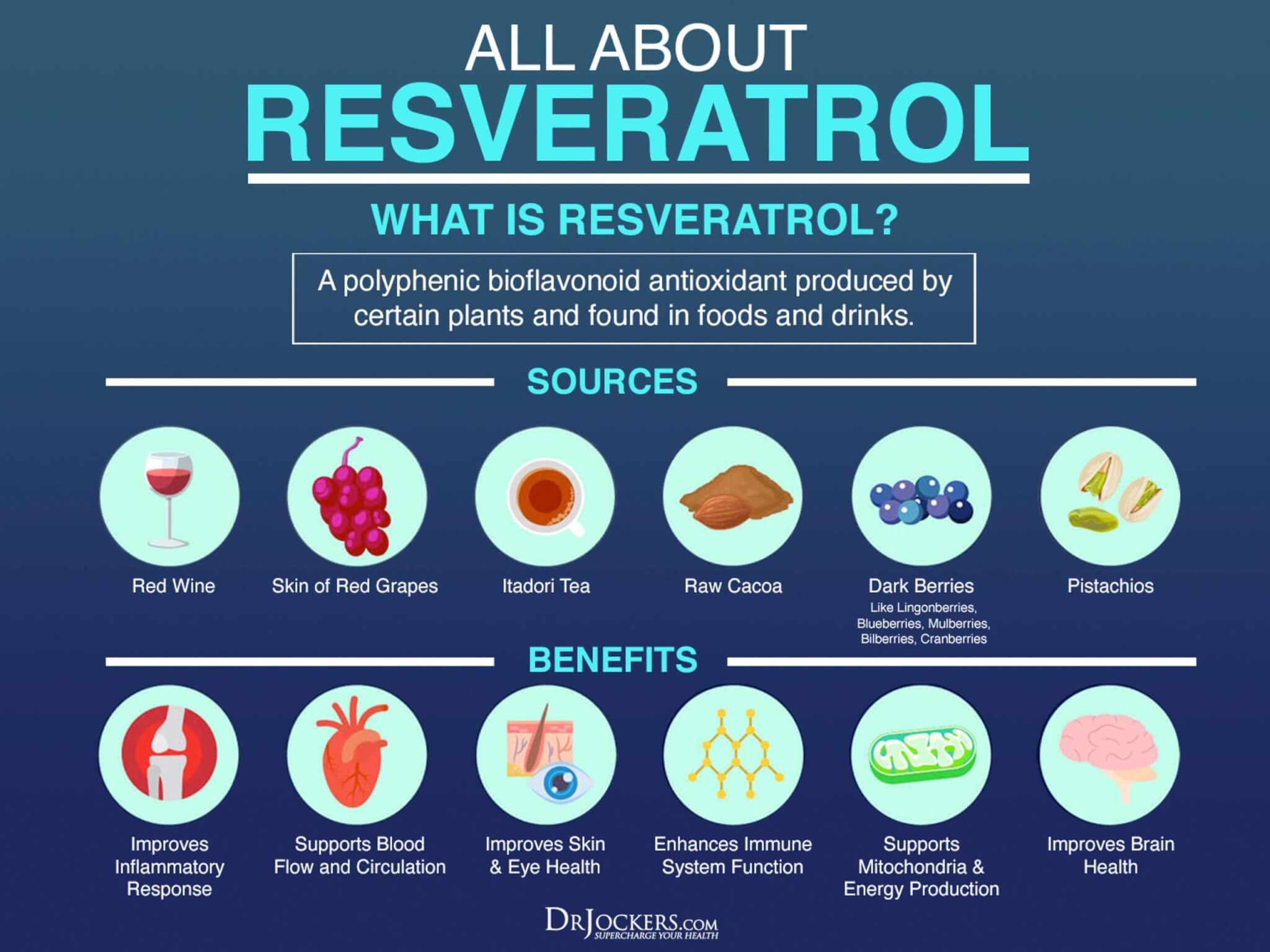
Omega-3 Fatty Acids
Omega 3 fatty acids maintain cellular membrane health and have antioxidant, anti-inflammatory, and antifibrotic properties. Supplementing with these essential fatty acids may be very helpful for individuals with scleroderma.
Cod Liver oil is one of the world’s best sources of the omega 3 fatty acids rich in both EPA and DHA. DHA is the most important essential fat for good eye health and EPA also plays a helpful role.
In addition, Cod Liver oil is a fantastic source of retinol, which is the vital fat-soluble form of vitamin A that supports immune health. Vitamin A helps create “killer cells” lymphocytes which attach foreign invaders and produce antibodies.
On top of that, it also supplies us with vitamin D. Many brands have it in either a capsule form or a lemon-flavored oil so it doesn’t taste bad at all and is easy to swallow.

Curcumin
Turmeric is a powerful herb with abundant health benefits. It has been used for centuries to treat a variety of conditions. Turmeric has anti-inflammatory, antioxidant, anti-thrombotic, and antimicrobial properties.
Curcumin is the active component of turmeric. Due to its antioxidant, anti-inflammatory effects, curcumin has an important role in supporting people with autoimmune conditions (12). A supplement I often use to help improve inflammatory expression contains compounds such as curcumin, proteolytic enzymes, boswelia, resveratrol, rosemary and quercetin.
While this product can greatly improve immune function and positively impact inflammation, it is important to note that this product is not FDA approved to prevent, mitigate, treat or cure scleroderma and should not be confused as such.

9. Physical Therapy, Movement, and Chiropractic Care
Physical therapy, movement, and chiropractic care may help people who are suffering from stiff and painful joints due to scleroderma. Many people with scleroderma experience the loss of joint motion, which occurs when blood flow decreases, and their skin becomes taut. Exercises that increase range of motion include stretching the fingers, hands, wrists, and shoulders. Strengthening the fingers and hands is also important.
Maintain normal daily activities as best you can to keep the body flexible, improve circulation, and relieve stiffness. Low impact exercise and other activities can help keep joints flexible, reduce pain, and improve balance and strength.
Chiropractic care may also be helpful. Increased stress on the body causes subluxation, which is the mechanical compression and irritation of spinal joints and nerves. Chiropractic care can remove upper cervical subluxations and restore proper structural and neurological function to the spine and nervous system.

Inflammation Crushing Ebundle
The Inflammation Crushing Ebundle is designed to help you improve your brain, liver, immune system and discover the healing strategies, foods and recipes to burn fat, reduce inflammation and Thrive in Life!
As a doctor of natural medicine, I have spent the past 20 years studying the best healing strategies and worked with hundreds of coaching clients, helping them overcome chronic health conditions and optimize their overall health.
In our Inflammation Crushing Ebundle, I have put together my very best strategies to reduce inflammation and optimize your healing potential. Take a look at what you will get inside these valuable guides below!
Conclusion
Scleroderma is an autoimmune condition that involves the hardening and tightening of the skin and connective tissues. When you have scleroderma, your cells make too much collagen, as if you were injured and needed to replace dead skin.
Scleroderma affects women more often than men and most commonly occurs between the ages of 30 and 50. Scleroderma often accompanies other immune system disorders, including rheumatoid arthritis and lupus.
There are two main types of scleroderma: localized scleroderma and systemic scleroderma. Localized scleroderma affects only the skin. In many people, scleroderma is systemic and harms structures beyond the skin, such as blood vessels, internal organs, and the digestive tract.
Signs and symptoms vary, depending on which type of scleroderma you have. Some symptoms of scleroderma include dry, stiff skin, red spots on the hands and face, fatigue, pain, dry mouth, shortness of breath, heartburn and other gastrointestinal issues, abnormal heartbeat, and headaches.
There are natural support strategies that may be very helpful for anyone with scleroderma. An anti-inflammatory autoimmune elimination diet may be very helpful for anyone with scleroderma. Other strategies include addressing Raynaud’s, supporting the mitochondria, improving gut health, strengthening the gut mucosa, supporting the immune system, and moisturizing the skin. Physical therapy, movement, and chiropractic care may also be very helpful.
If you want to work with a functional health coach, I recommend this article with tips on how to find a great coach. On my website, we offer long-distance functional health coaching programs. For further support with your health goals, just reach out and our fantastic coaches are here to support your journey.




Hi Dr Jockers
It was fascinating to9 read about olive leaf as an immune system supplement. I must confess that I have not heard o this supplement before. This surprises me because I do try to stay abreast of all things dietary.
I don’t have scleroderma, but I do have multiple sclerosis. This, also, is an autoimmune disease. But, why am I telling you this? You are a doctor and you know this far better than I do.
Many of the tips you have mooted for scleroderma also apply to MS. So, thank you for your work on traising autoimmune disease awareness.
Yes olive leaf can be very helpful!
I had never heard of scleroderma before Bob Saget passed, and now I myself have been diagnosed with the condition. I really appreciate DRs like you who try to make this information accessible. Thank you.
I have had systemic scleroderma since 2003. I’m very fortunate that my lungs and heart are not diseased. My fingers are contracted, and I do have gastrointestinal issues that are controllable. I’ve been in remission since 2006.
I now have a shoulder with three full tears. The surge has recommended shoulder replacement. I’m a very active 75. I ride horses also.
My question is, will the surgery trauma cause the scleroderma to again become active?
Thank you.
Marilyn
Sorry to hear about this! It is hard to say for sure, best to consult with your physicians on this matter.